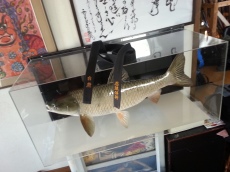From Shiro Kuma's Weblog by kumafr
Tag: General thoughts
Rank Is Not Competence
From Shiro Kuma's Weblog by kumafr
I have been traveling to train in Japan over 50 times over the last 23 years. I’m what you can call a “Jurassic ninja”.
But yesterday for the first time I forgot my belt on the mats. I left it right after Nagato sensei’s class and it made me think on the value one attaches to this piece of fabric and what does rank really means.
Luckily for my ego, my friend Joe Maurantonio message me that he found it and put it on the big koi at the entrance of the dôjô. And luckily I didn’t forget my key of the dôjô so I got it back.
Henka: A Poetic Strangeness
From Shiro Kuma's Weblog by kumafr
Yama Michi
From Shiro Kuma's Weblog by kumafr
In a recent and interesting article Dan Ordoins quoted Emerson: “Do not go where the path may lead, go instead where there is no path and leave a trail.”
Thank you Dan this sentence made me think a lot!
What does it mean for a Bujinkan practitioner? How can we manage it own trail while obeying to our master?
In my opinion it is possible if we rewrite it as follow: “once you have acquired the necessary knowledge and reached the jûgodan level it is not anymore necessary for you to go where the path may lead, go instead where there is no path and leave a trail”.
In japanese 山道 yama michi (mountain trail) gives this idea of difficulty of trekking but also the importance of 道 michi or dô (the path, the way.
Therefore “leaving a trail” is creating your own taijutsu and this can only be achieved if you reach the level where it creates itself.
In a private discussion with sensei a few years ago, he told me that all jûgodan were turning into little Sôke…and that it was good because it meant that he had been able to transmit the essence of ninpô.
This is this essence that matters but it can only be found if you have a guide, a master, a “sensei” to teach it to you.
Without a real sensei, without the be respect and obedience you owe him there is no way you can “leave a trail”.
Bujinkan is about survival, so choose wisely your next step.
Japan Trip April 2012 – Diary
From Shiro Kuma's Weblog by kumafr
I came back yesterday from a fantastic trip and I hope you have been able to share with me the things I trained in Noda.
I have been asked in Japan why I was writing so much*. It is to share with the community some of the knowledge we get in Japan with Sôke and the shihan. I hope it will help you to wait for your next trip.
These texts* and these pictures are my attempt to give a fair image of what is happening in Japan. This is why I have added many pictures to these texts.
I took many pictures and not all are good but please see them as a training documentary. Pictures being forbidden during training, you will mainly have pictures taken before and after the class. As today someone asked me to put a link here to access the pictures uploaded on facebook during my trip you will find them below:
The first album contains the first 10 days (over 500 pict):
https://www.facebook.com/media/set/?set=a.3395318174028.144619.1601937800&type=3
and the second one only the last day (around 100 pict):
https://www.facebook.com/media/set/?set=a.3464131334314.145724.1601937800&type=3
Enjoy and comment them if you feel like it.
*All the texts in this blog were uploaded in April. If you want to read them again, click on “April 2012″ in the home page and they will appear.


